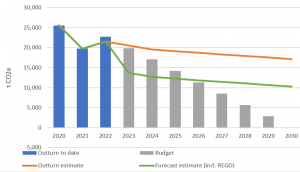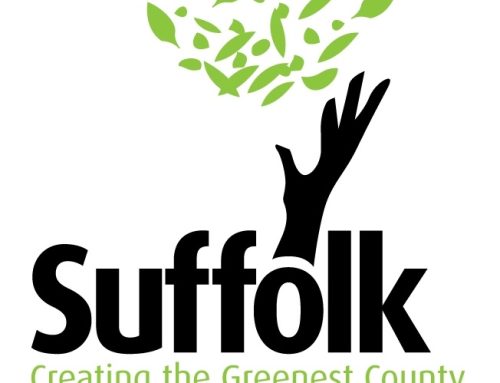[Source: Suffolk County Council]
Suffolk County Council has reduced its carbon emissions by 15% (or 4,000 tonnes CO2e) in the last two years, on its ambitious journey to net zero by 2030.
The results are set out in a report to Cabinet, which provides a progress update on the council’s ambition to reduce its own emissions and energy costs, while inspiring and supporting others to do the same.
It is one of only a few local authorities in the country to publish a ‘Carbon Budget’. This looks in detail at its environmental impact, to identify actions and costs needed to reduce emissions.
Cllr Richard Rout, Deputy Leader and Cabinet Member for Finance and Environment, said
“The council has made incredible progress in the last few years to reduce its carbon emissions, but we are very open about the fact we still have a long way to go and much work to do.
Since March 2019, when we declared a climate emergency, I have been adamant that achieving net zero by 2030 will be tough. But it’s a challenge that we simply must rise to, so that we can stand tall as an authority knowing that we’re doing the best we can to reduce our operating costs as an organisation and eliminate as many carbon emissions as possible.
The council is not immune to the rising energy costs confronting residents and businesses across the country and this work has an important role to play in making our buildings more efficient and cheaper to run. For example, we have reduced gas consumption in one of our properties, Constantine House, by 80% over a 12-month period.”
Calculating the council’s carbon emissions is a complex process. Papers released last month, ahead of a Council Scrutiny Committee meeting on 9 January, explain the work that the council has been doing in the last year, as it works towards net zero by 2030.
The council is reducing the emissions that it is directly responsible for, following a £12.8m ‘spend to save’ investment to decarbonise its buildings, making them more energy efficient and cheaper to run.
Changes it is making include moving its small vehicle fleet to fully electric by 2025, it has upgraded street lighting across the county, changed to a renewable electricity tariff, and is increasing the number of solar panels across its estate.
But one of the elements that will determine the council’s progress to net zero, is the ambition shown by the businesses in its supply chain. Although these are not carbon emissions directly produced by the council, its suppliers and contractors still affect the council’s target.
“We can’t control the carbon emissions produced by the businesses we work with, but we can choose who we work with. We seek out businesses who provide good value, offer social value, but also have their own net zero ambitions.
We understand that small and medium size businesses may need help on their journey, and we can help them through our Carbon Charter scheme. This supports businesses to deliver carbon reductions and recognises that many of them, like us, need to reduce their energy costs at this challenging time.
There is also support available from the Free Net Zero Business Advisor service for any Suffolk-based business. This is funded through the Suffolk Climate Emergency Plan, where we work with all Suffolk councils, coming together to help people across the county to play their part.”
Cllr Richard Rout
The Carbon Budget also looks ahead to the target year of 2030. Although good progress has been made, there is still a lot of work needed to achieve the net zero ambition. The graph below shows the actual emissions (in blue) and the projected emissions out to 2030 (green and orange lines). The grey bars show the rate of decrease that would be needed to achieve zero carbon by 2030.

Emissions since 2020 and projected to 2030
The Carbon Budget will be presented at a Scrutiny Committee meeting on 9 January, and will then be discussed at the Full Council meeting on 9 February 2023.






